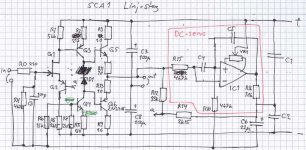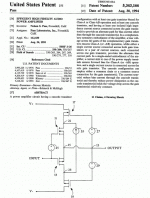John,
My understanding is that it is a Rush Cascode, discovered by Christopher Rush, I believe an Englishman, in 1964.
I'm not surprised Widler used it. He was a legend, spent a lot of time in Puerto Rico, IIRC. Didn't he die a year or two back? Brilliant, irreverent man with an impish sense of humor.
Cheers,
Hugh
My understanding is that it is a Rush Cascode, discovered by Christopher Rush, I believe an Englishman, in 1964.
I'm not surprised Widler used it. He was a legend, spent a lot of time in Puerto Rico, IIRC. Didn't he die a year or two back? Brilliant, irreverent man with an impish sense of humor.
Cheers,
Hugh
AKSA said:John,
My understanding is that it is a Rush Cascode, discovered by Christopher Rush, I believe an Englishman, in 1964.
Aare you referring to post 55? Assuming Vbb is a fixed voltage
it seems like an ordinary cascode to me. AFAIK A Rush cascode
uses both bases as inputs, ie. also Vbb would be an input.
Typically, in a Rush cascode one input is the signal input and the
other the feedback input.
P.S. Hugh, sorry for the long interruption in our email conversation.
After 7+ weeks I still can't read my email. This is getting ridiculous.
I don't know if my ISP are just understaffed, incompetent or
whatever, but it is certainly far far beyond the acceptable.
No problem, Christer,
I'm busy as hell at present, whenever you are ready.
We certainly have much to discuss!
Yes, you are right. Tom Holman used the Rush in his legendary phono design for the NAD 3020 quite a few years back. Very interesting design, and Kamijo has used it in his Evolve tube/hybrid designs as well.
It can also be used like a normal cascode, of course, with merely bias at one base and signal at the other.
Hugh
I'm busy as hell at present, whenever you are ready.
We certainly have much to discuss!
Yes, you are right. Tom Holman used the Rush in his legendary phono design for the NAD 3020 quite a few years back. Very interesting design, and Kamijo has used it in his Evolve tube/hybrid designs as well.
It can also be used like a normal cascode, of course, with merely bias at one base and signal at the other.
Hugh
Cherry used one in his NDFL amp. He refers to it as a Rush amp too.AKSA said:My understanding is that it is a Rush Cascode, discovered by Christopher Rush, I believe an Englishman, in 1964.
Cascoding the output stages makes the sound lack of dynamic. This is written in the A75 paper, when the authors considers not to use cascode in the output stage.
What about this patent of Mr. Pass? The device 11 and 13 is cascoded so the current source 33 can give big bias current in low voltage (less heat).
In this particular circuit, while cascoding will give lack of dynamic, what about the contribution of high current flowing? Will the total output of this patent similiar to ordinary output cascoding, or it will be compeltely different sound compared to output stage cascoding?
What about this patent of Mr. Pass? The device 11 and 13 is cascoded so the current source 33 can give big bias current in low voltage (less heat).
In this particular circuit, while cascoding will give lack of dynamic, what about the contribution of high current flowing? Will the total output of this patent similiar to ordinary output cascoding, or it will be compeltely different sound compared to output stage cascoding?
Attachments
Ten yrs. ago, my 1st experiment with cascode was on the front diff. , the details improved vastly, but so unnatural that I shew it to none of my friends, it was a disgrace. My second experiment was with 2nd VAS stage, the sound were as if there was no cascode, exactly the same like with one transistor. More experiments gained no improvement. Then I returned to basic electronics self-study, as my knowledge increase, so increase the quality of my cascode, for me now cascode is a must. But I spent over thousand hours studying electronics including a heftty cash buying things, : doesn't worth it.
- Status
- This old topic is closed. If you want to reopen this topic, contact a moderator using the "Report Post" button.
- Home
- Amplifiers
- Solid State
- The sound of cascodes

